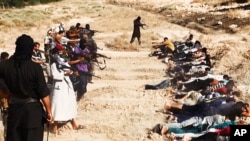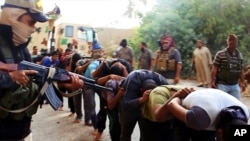In releasing photos linked to an apparent massacre, the Islamic militants powering through northern Iraq have broadened their aggressions to another battlefield: social media.
“It’s an expansion of terrorism,” said Susan Moeller, an expert on the use of photography in conflict.
The Islamic State of Iraq and the Levant (ISIL) last week seized several key cities in the Tigris valley, routing soldiers and civilians alike. This weekend, via Twitter, the al-Qaida splinter group distributed a series of photos showing the capture and execution of troops stationed at an air base near the city of Tikrit.
ISIL claimed to have killed 1,700 men out of 2,500 taken at Speicher air base, a former post for U.S. troops. Iraqi officials confirmed the photos’ authenticity but said the death toll was greatly inflated and instead probably is in the hundreds.
“False news has been circulated about an exaggerated number of soldiers and volunteers killed by ISIL gangs. This news item is baseless,” Brigadier General Fadhil Abdul-Sahib told the Associated Press on Monday.
According to Reuters, a former Tikrit official in Tikrit said ISIL had captured 450 to 500 troops at Speicher and another 100 elsewhere in Tikrit. The news agency reported Monday that another 200 government troops were believed to be “holding out” at Speicher.
The U.S. State Department could not verify the number of people killed. But spokeswoman Jen Psaki on Sunday called the claim “a true depiction of the bloodlust that those terrorists represent.”
Grim depictions
One of the ISIL photo shows barefoot men in plain clothes hunched over – heads down, hands resting on the person ahead – moving single file before a masked man with a raised assault weapon.
Another shows an armed, masked man presiding over captives huddled face down in a truck bed. Still another photo shows captives sitting on the ground, their faces visible and fearful, beneath ISIL’s black banner.
A chilling photo shows dozens of men lying in a row, face down on sandy ground, while men in a row behind them point guns. Near the prone men, plumes of sand and dust rise, probably stirred by bullets.
“This is the fate of the Shiites which Nouri brought to fight the Sunnis,” one photo was captioned, Reuters reported.
Iraqi Prime Minister Nouri al-Maliki, a Shiite, has been criticized by the U.S. government and others for failing to unify the country’s sectarian factions, which include Sunnis and, in the north, Kurds.
Graphic power play
The photos represent a graphic display of ferocity and strength, said Moeller, author of the 2009 book, “Packaging Terrorism: Co-opting the News for Politics and Profit.”
“They’ve taken the pictures as a further terrorist tool,” said Moeller, a journalism professor at the University of Maryland, where she also directs the International Center for Media and the Public Agenda.
Moeller said the photos function as a form of advertising.
“If you are an organization that is trying to show itself as powerful and … not just about rhetoric but about action, then posting these kinds of images gives the organization authority in a way that just posting your leadership speaking on a webcam does not.”
Capturing a sequence of images – especially those that depict the insurgents exerting dominance over their subjects – demonstrates an exercise of power, she added.
“Particularly in a social-media world, you post the photos that show your agency, your control,” she said. “… It’s going to make it clear to the audience of this horror-porn … that you’re doing it intentionally.”
The goals can be to instill fear, to establish dominance, to recruit new members to the cause.
Propaganda history
Images have long been used as tools of war, and they’ve been employed in social-media propaganda for years now, Moeller said.
She noted the 2002 case in which Islamic terrorists in Pakistan made a grisly video of beheading Wall Street Journal reporter Daniel Pearl, whom they’d accused of spying.
And in 2003, Moeller noted, the U.S. Defense Department released allied journalists’ photos of the bodies of the late dictator Saddam Hussein’s sons, Uday and Qusay, as evidence they’d been killed in a shootout with American forces in Mosul.
Authenticating images can be challenging
One way is to “get the raw data off the photo” – the date, GPS and other location recorded on many digital cameras, Moeller said.
Another is to find clues within the visual information of the photo itself. Does it look like a desert or whatever the location is purported to be? Is there a sign or some other marker? Does the image suggest a time of day or a particular kind of weather?
A third way is to release the information, eliciting a response. When the photos of the Hussein sons’ deaths first came out, “there were a lot of questions about whether the photos had been doctored,” said Moeller, who wrote about the case in her book. But she said their deaths were authenticated when “someone from their group posted a video saying, ‘We will avenge their deaths.’ “
The ideal in authentication is to obtain evidence or, even better, confirmation using all three methods. "You want to try triangulation," Moeller said.
As for the ISIL photos, Moeller said they should be understood “not only as documents of war crimes but as calculated tools in a power grab.
“If you only see them as war crimes, then you think the people who committed these acts are not just evil but demented,” she explained. “But if you see these as tools in a calculated chess game, however perverted, then all of a sudden there’s an intellect at work – and that gives the outside world and other actors within Iraq insight into how to respond, how to react.”
But, Moeller acknowledged, “it doesn’t change the horror of it.”
Some information for this report was provided by the Associated Press and Reuters.
“It’s an expansion of terrorism,” said Susan Moeller, an expert on the use of photography in conflict.
ISIL Attacks in Iraq
ISIL Attacks in Iraq- June 10: Mosul captured
- June 11: Tikrit and parts of Beiji captured
- June 12: Samarra and Dhuluiya captured
- June 13: Jalawla and Saadiyah captured
- June 14: Clashes in Ishaki and Dujail
- June 16: Tal Afar captured
ISIL claimed to have killed 1,700 men out of 2,500 taken at Speicher air base, a former post for U.S. troops. Iraqi officials confirmed the photos’ authenticity but said the death toll was greatly inflated and instead probably is in the hundreds.
“False news has been circulated about an exaggerated number of soldiers and volunteers killed by ISIL gangs. This news item is baseless,” Brigadier General Fadhil Abdul-Sahib told the Associated Press on Monday.
According to Reuters, a former Tikrit official in Tikrit said ISIL had captured 450 to 500 troops at Speicher and another 100 elsewhere in Tikrit. The news agency reported Monday that another 200 government troops were believed to be “holding out” at Speicher.
The U.S. State Department could not verify the number of people killed. But spokeswoman Jen Psaki on Sunday called the claim “a true depiction of the bloodlust that those terrorists represent.”
Grim depictions
One of the ISIL photo shows barefoot men in plain clothes hunched over – heads down, hands resting on the person ahead – moving single file before a masked man with a raised assault weapon.
Another shows an armed, masked man presiding over captives huddled face down in a truck bed. Still another photo shows captives sitting on the ground, their faces visible and fearful, beneath ISIL’s black banner.
A chilling photo shows dozens of men lying in a row, face down on sandy ground, while men in a row behind them point guns. Near the prone men, plumes of sand and dust rise, probably stirred by bullets.
“This is the fate of the Shiites which Nouri brought to fight the Sunnis,” one photo was captioned, Reuters reported.
Iraqi Prime Minister Nouri al-Maliki, a Shiite, has been criticized by the U.S. government and others for failing to unify the country’s sectarian factions, which include Sunnis and, in the north, Kurds.
Graphic power play
The photos represent a graphic display of ferocity and strength, said Moeller, author of the 2009 book, “Packaging Terrorism: Co-opting the News for Politics and Profit.”
“They’ve taken the pictures as a further terrorist tool,” said Moeller, a journalism professor at the University of Maryland, where she also directs the International Center for Media and the Public Agenda.
Moeller said the photos function as a form of advertising.
“If you are an organization that is trying to show itself as powerful and … not just about rhetoric but about action, then posting these kinds of images gives the organization authority in a way that just posting your leadership speaking on a webcam does not.”
Capturing a sequence of images – especially those that depict the insurgents exerting dominance over their subjects – demonstrates an exercise of power, she added.
“Particularly in a social-media world, you post the photos that show your agency, your control,” she said. “… It’s going to make it clear to the audience of this horror-porn … that you’re doing it intentionally.”
The goals can be to instill fear, to establish dominance, to recruit new members to the cause.
Propaganda history
Images have long been used as tools of war, and they’ve been employed in social-media propaganda for years now, Moeller said.
She noted the 2002 case in which Islamic terrorists in Pakistan made a grisly video of beheading Wall Street Journal reporter Daniel Pearl, whom they’d accused of spying.
And in 2003, Moeller noted, the U.S. Defense Department released allied journalists’ photos of the bodies of the late dictator Saddam Hussein’s sons, Uday and Qusay, as evidence they’d been killed in a shootout with American forces in Mosul.
Authenticating images can be challenging
One way is to “get the raw data off the photo” – the date, GPS and other location recorded on many digital cameras, Moeller said.
Another is to find clues within the visual information of the photo itself. Does it look like a desert or whatever the location is purported to be? Is there a sign or some other marker? Does the image suggest a time of day or a particular kind of weather?
A third way is to release the information, eliciting a response. When the photos of the Hussein sons’ deaths first came out, “there were a lot of questions about whether the photos had been doctored,” said Moeller, who wrote about the case in her book. But she said their deaths were authenticated when “someone from their group posted a video saying, ‘We will avenge their deaths.’ “
The ideal in authentication is to obtain evidence or, even better, confirmation using all three methods. "You want to try triangulation," Moeller said.
As for the ISIL photos, Moeller said they should be understood “not only as documents of war crimes but as calculated tools in a power grab.
“If you only see them as war crimes, then you think the people who committed these acts are not just evil but demented,” she explained. “But if you see these as tools in a calculated chess game, however perverted, then all of a sudden there’s an intellect at work – and that gives the outside world and other actors within Iraq insight into how to respond, how to react.”
But, Moeller acknowledged, “it doesn’t change the horror of it.”
Some information for this report was provided by the Associated Press and Reuters.











